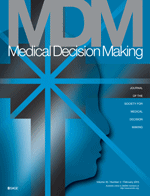Background to the Task Force
A new Good Research Practices in Modeling Task Force was constituted by the ISPOR Board of Directors in 2010 and the Society for Medical Decision Making was invited to join the effort.
Early in 2010, the ISPOR and SMDM boards appointed the co-chairs and consented to the proposed members of the Task Force. The Task Force convened expert developers and experienced users of models from academia, industry, and government, with representation from many countries. Given the breadth of the field at this point, a decision was made to divide the topic into six components and leads were appointed for each working group. Three of these topics covered the aspects felt to be general to all models in our field: conceptualization of a model, estimation of model parameters and handling of uncertainty, and validation of models and concerns for transparency. The other three dealt with specific techniques in common use: state-transition modeling, discrete event simulation, and dynamic transmission models. While there are undoubtedly topics of interest that are not addressed in these six articles, it was believed that these reports would cover the major areas that are at a stage of development appropriate for issuing guidelines.
The Task Force held its first meeting via teleconference on May 7, 2010, and hosted information sessions during 2010 at the ISPOR 15th Annual International Meeting in Atlanta, GA, at the 32nd Annual Meeting of the Society for Medical Decision Making in Toronto, ON, and at the ISPOR 13th Annual European Congress in Prague. Over numerous teleconferences, and occasional in-person meetings, the working groups produced draft reports for each section. Although the groups referred to the literature frequently, there was no systematic attempt to review it. Although substantiated as much as possible, the recommendations that emerged represent the opinions of the experts in the Task Force. These were not forced to consensus, and had substantial differences of opinion remained, they would have been documented as such. The draft recommendations were discussed by the Task Force as a whole in a meeting held in Boston in March 2011 and subsequently edited and circulated to the Task Force members in the form of a survey where each one was asked to agree or disagree with a recommendation, and if the latter, to provide the reason(s). Each group received the results of the survey and endeavored to address all rejections. In the end, there were no dissenting positions. The final drafts of the articles were posted on the ISPOR and SMDM Web sites for comment by the general membership of the societies.
A second group of experts—again, with broad representation of modelers and users of models—was invited to formally review the articles. Their comments were addressed by each working group, and revised drafts of each article were circulated to the Task Force as a whole. After receiving any additional comments and considering any further revisions, the final version of each article was prepared. (Additional materials related to the Task Force are available at the SMDM website: (http://www.smdm.org/ispor_smdm.shtml)
A summary of these papers was presented at a plenary session of the ISPOR 16th Annual International Meeting in Baltimore, MD in May 2011, and again at the 33rd Annual Meeting of the Society for Medical Decision Making in Chicago, IL in October 2011. The final versions of the papers were then submitted simultaneously to Value in Health and Medical Decision Making. Other papers in this series [1-6] describe best practices for building and applying particular types of models, addressing uncertainty and ensuring transparency and validity.
- Mark Roberts, Louise B. Russell, A. David Paltiel, Michael Chambers, Phil McEwan, and Murray Krahn. Conceptualizing a Model: A Report of the ISPOR-SMDM Modeling Good Research Practices Task Force–2 Med Decis Making September–October 2012; 32: 678-689. doi:10.1177/0272989X12454941
- Uwe Siebert, Oguzhan Alagoz, Ahmed M. Bayoumi, Beate Jahn, Douglas K. Owens, David J. Cohen, and Karen M. Kuntz. State-Transition Modeling: A Report of the ISPOR-SMDM Modeling Good Research Practices Task Force–3. Med Decis Making September–October 2012; 32: 690-700. doi:10.1177/0272989X12455463
- Jonathan Karnon, James Stahl, Alan Brennan, J. Jaime Caro, Javier Mar, and Jörgen Möller. Modeling Using Discrete Event Simulation: A Report of the ISPOR-SMDM Modeling Good Research Practices Task Force–4. Med Decis Making September–October 2012; 32: 701-711. doi:10.1177/0272989X12455462
- Richard Pitman, David Fisman, Gregory S. Zaric, Maarten Postma, Mirjam Kretzschmar, John Edmunds, and Marc Brisson. Dynamic Transmission Modeling: A Report of the ISPOR-SMDM Modeling Good Research Practices Task Force Working Group–5. Med Decis Making September–October 2012; 32: 712-721. doi:10.1177/0272989X12454578
- Andrew H. Briggs, Milton C. Weinstein, Elisabeth A. L. Fenwick, Jonathan Karnon, Mark J. Sculpher, and A. David Paltiel. Model Parameter Estimation and Uncertainty Analysis: A Report of the ISPOR-SMDM Modeling Good Research Practices Task Force Working Group–6. Med Decis Making September–October 2012; 32: 722-732. doi:10.1177/0272989X12458348
- David M. Eddy, William Hollingworth, J. Jaime Caro, Joel Tsevat, Kathryn M. McDonald, and John B. Wong On Behalf of the ISPOR-SMDM Modeling Good Research Practices Task Force. Model Transparency and Validation: A Report of the ISPOR-SMDM Modeling Good Research Practices Task Force–7. Med Decis Making September–October 2012; 32: 733-743. doi:10.1177/0272989X12454579
